
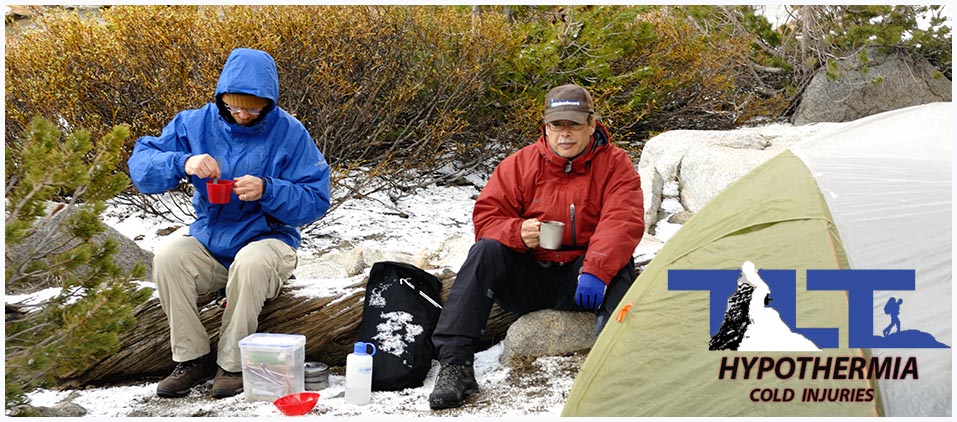 HYPOTHERMIA - in the mountains, as well as in many other outdoor locations (or even in a cold home with elderly folks), is a very real danger. Most people think of hypothermic danger when temperatures are below freezing, but in reality, most cases occur when temperatures are well above freezing. The reason for this is anyones guess, but it could be that people simply take below freezing temperatures much more serious and therefore, properly prepare for them. But hypothermia can set in under any condition where the body is losing more heat than it is generating. The elderly are particularly susceptible to this. I have known older folks who have complained about the cold when temperatures were in the 80's (Degrees Fahrenheit) and even higher. So obviously there is a lot going on when it comes to the body's ability to fight off cold.
HYPOTHERMIA - in the mountains, as well as in many other outdoor locations (or even in a cold home with elderly folks), is a very real danger. Most people think of hypothermic danger when temperatures are below freezing, but in reality, most cases occur when temperatures are well above freezing. The reason for this is anyones guess, but it could be that people simply take below freezing temperatures much more serious and therefore, properly prepare for them. But hypothermia can set in under any condition where the body is losing more heat than it is generating. The elderly are particularly susceptible to this. I have known older folks who have complained about the cold when temperatures were in the 80's (Degrees Fahrenheit) and even higher. So obviously there is a lot going on when it comes to the body's ability to fight off cold.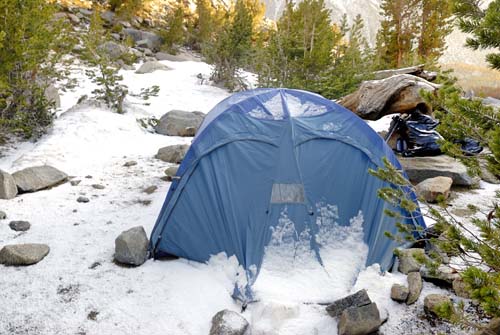 The human body strives to maintain a temperature at a steady 98.6 degrees Fahrenheit. Anything below this begins to cause stress on the system. Mild hypothermia would set in with a body core temperature between normal and 96 F. Moderate would be 92-96 F, and severe would be 86-92 F. Below 86 F, death is likely.
The human body strives to maintain a temperature at a steady 98.6 degrees Fahrenheit. Anything below this begins to cause stress on the system. Mild hypothermia would set in with a body core temperature between normal and 96 F. Moderate would be 92-96 F, and severe would be 86-92 F. Below 86 F, death is likely.The body's priority is keeping internal organs at that ideal operating temperature (98.6 F). Proper operating temperature is critical because our body is a chemical factory and all the reactions that take place must happen under precise conditions. Above 105 Fahrenheit many body enzymes become denatured and chemical reactions cannot take place Below 98.6 F chemical reactions slow down or even cease. When the body cannot function chemically, death comes quickly.
This is particularly true when it comes to vital organs such as the heart, lungs and brain. This is why the body when faced with heat loss, the human system will begin to shut down blood flow to the extremities such as the hands, arms, feet, legs, nose, and ears. It does this so that precious heat will be preserved for the vital organs to maintain life.
Now to understand what we need to be aware of when it comes to preventing hypothermia in the mountains (or anywhere else for that matter), is an understanding of how the body looses heat. Having knowledge in the area of heat loss will better enable us to take preventative measures. The different forms of heat loss are as follows: CONVECTION:
This type of heat loss has to do with the movement of molecules across the surface of your body parts. It works this way. When the temperature gradient as explained above is below the 98.6 degrees Fahrenheit, your body will loose heat to its surroundings, because the air molecules that come in contact with your skin absorb heat from your body. Now when these air molecules are moving at a faster rate, such as in windy conditions, your body is constantly being bombarded by newly arriving cold molecules that suck away heat at an alarming rate. This is true not only for moving air, but of any moving substance coming in contact with your skin. Moving water would be a good example of another substance that causes heat loss and when is motion it causes even greater heat loss.
This is what wind-chill is all about. Cold coupled with a wind is always more serious when it comes to hypothermia. The below chart demonstrates this when it comes to the danger of frostbite.
(Information from the NWS)
TEMPERATURE (Degrees Fahrenheit)
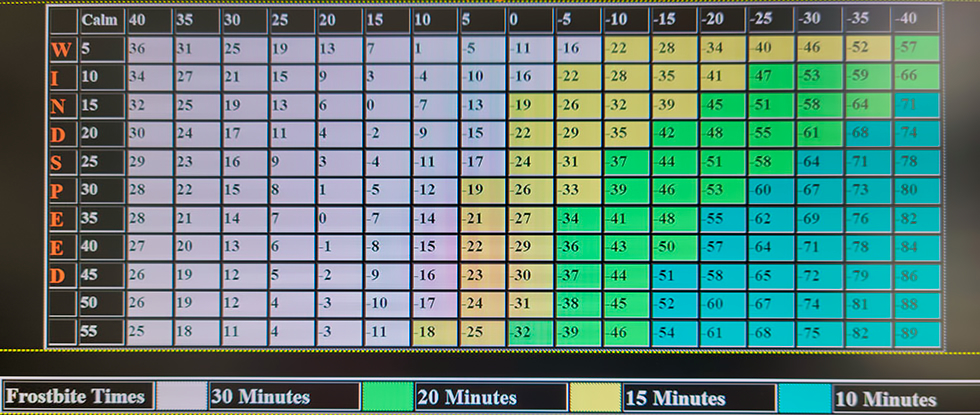
Under wet conditions, these times could change dramatically for the worse)
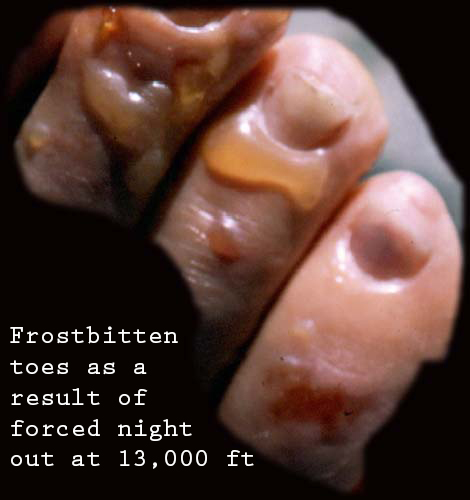 The image to the left is a photo of a few of the toes on my right foot after incurring Frostbite on Split Mountain in the Sierra Nevada. This was a result of a forced bivouac at approximately 13,000 feet (see photo at top of this page). We will discuss frostbite latter on.
The image to the left is a photo of a few of the toes on my right foot after incurring Frostbite on Split Mountain in the Sierra Nevada. This was a result of a forced bivouac at approximately 13,000 feet (see photo at top of this page). We will discuss frostbite latter on.HOW TO AVOID HEAT LOSS DUE TO CONVECTION:
1) Take shelter from the wind (get into your tent or bivy bag, or get under a rock or into some other form of natural shelter)
2) Put on a good windbreaker (with hood) in order to stop the movement of air across the body. Wind pants should also be used when you are in cold and windy conditions.
(A windbreaker and/or wind pants are best made from a material that does double duty of keeping moisture out while letting moisture from within escape. Fabrics such as Gortex@ work great).
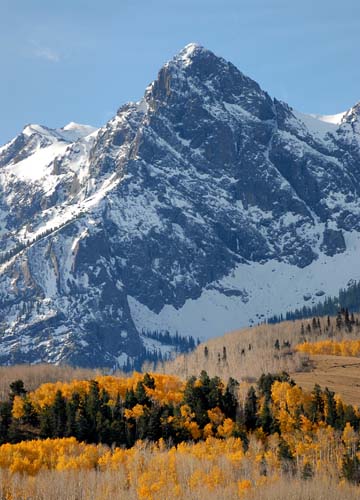 EVAPORATION:
EVAPORATION:Heat is required or lost anytime a substance changes state (solid to liquid, liquid to gas, etc) For evaporation to take place, heat is required to change a liquid to a gas. This is why the body uses the mechanism of sweat to cool the body. When the liquid sweat from the body comes in contact with moving air, evaporation takes place. This draws heat from the body to facilitate the change in state from liquid to gas. While this works perfectly well during hot or warm conditions, evaporation is not a good thing when hypothermia is a danger.
Further loss of heat in cold conditions from evaporation is common when the following occurs. A hiker is working hard going up a slope and begins to sweat because the body is burning a lot of fuel and needs to remove some of that extra heat. The hiker then stops to rest a bit, and the moving ambient air then comes in contact with the sweaty hiker. Evaporation then takes place. The hiker feels an immediate chill. This is the most common form of evaporative danger when it comes to hypothermia for the climber and/or hiker, etc.
HOW TO LESSEN THE DANGERS OF COLD FROM EVAPORATION:
1) Proper attention to clothing is critical here. You do not want to get soaked by excessive sweating when hiking or climbing. This really adds to heat loss due to evaporation, and even more so with the next topic we are going to discuss. This is why layering is so important when is comes to clothing. Better to feel good when hiking and stay dry, then to add more clothing just so you can stay warm when taking a short break. If you get your clothing all wet from sweating, it will be very difficult to get it dry under cold and/or damp conditions in the mountains or any other outdoor location.
2) Just like with convection, using a windbreaker type shell will greatly slow down heat loss due to evaporation. Also, to add a little sense to the first point just above, if you are done for the day, or if you are going to take an extended break, you need to adjust your clothing by removing anything that is wet, and adjust your layering so that you are warm enough to be comfortable.
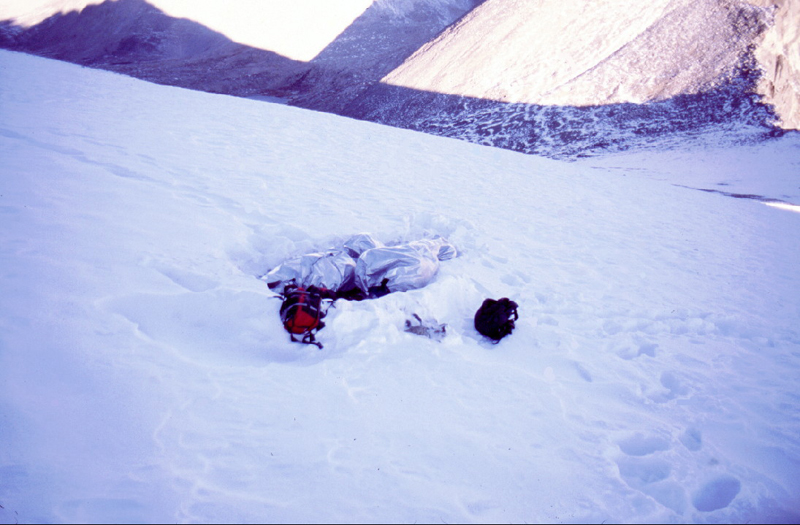 CONDUCTION:
CONDUCTION:This is the simplest form of heat loss to understand. It is the loss of heat to the environment due to the temperature gradient between the body and whatever it is in contact with. It is the temperature difference between the body (98.6 F) and the surrounding environment. If the current outdoor temperature for instance is 58.6 F, then we have a 40 degree temperature gradient or differential (98.6 degrees Fahrenheit minus 58.6 degrees Fahrenheit).
Conduction is the most serious type of heat loss because it is so rapid when compared to the others types of heat loss. It has to do with the warmth lost from direct contact with an object. A particularly severe type of conductive heat loss occurs when the body comes into contact with a cold solid or liquid material. Such materials have a much higher density, thermal conductivity, and heat capacity then air. This means that they can carry heat away from the body much faster rate. Steel, for example, is very dense, and if a very cold piece of it should come into contact with your skin, it could actually stick to it (causing you great personal injury). This is due to the instant loss of any warmth (which has been transferred from your skin to the steel) through the process of conduction.
But the greatest danger for the outdoorsman is water. It is reported that water has a 20-25 times greater ability to conduct heat away from the body than air does. Many people have died from hypothermia because of wet cold conditions due to this concept. This is why falling into a stream or lake is so deadly during times of very cold weather.
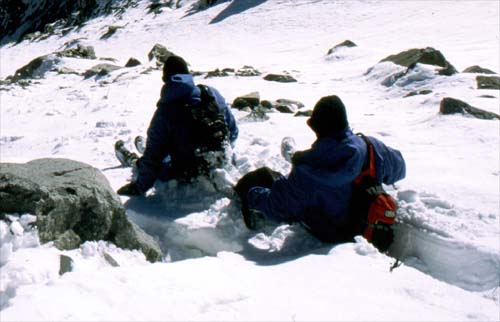 HOW TO REDUCE HEAT LOSS DUE TO CONDUCTION:
HOW TO REDUCE HEAT LOSS DUE TO CONDUCTION:- Immediately replace wet clothing with dry clothing - also dry any wet areas of the body off as best as possible.
- Do not risk falling into any water - falling into water under cold conditions could be a death sentence if you are unable to dry off and replace your wet clothing immediately.
- Always Insulate Between the Ground and Your Body - use a thermo-rest, a foam cell, or some other insulating type material between your sleeping bag and the ground. If conditions are cold, I will also take out my foam pad to sit on, or lie on, when taking an extended break or when in camp. Sitting around in the snow, or on a freezing rock, is a good way to get wet, and experience a good bit of heat loss due to conduction. As the saying goes: "Stay Dry = Stay Alive"
- Put on extra clothing - don't try and be macho, put your jacket on, or get into a sleeping bag so that you can insulate your body to prevent further heat loss due to the adverse temperature gradient. Don't forget to protect your head with a good insulating hat (or better yet balaclava). Figures have been quoted as high as 50% heat loss from your head and neck area. Carrying an extra hat or balaclava is a great lightweight option for extra warmth.
- Reduce the Temperature Gradient - by applying some sort of exterior heat source. But this is not always a practical option for mountaineers or wilderness travelers. A more practical approach would be to get inside a tent and wait for our body heat to warm up the air inside.
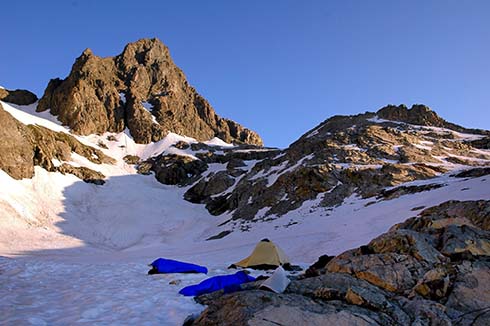 RADIATION:
RADIATION:This is the most complex and least understood form of heat loss. Thermal radiation is transmitted through air and space. It's a form of electromagnetic radiation like light and radio but at a lower frequency. Radiation transfers heat from hot things like the sun or embers in a fire, to colder things like your skin. An example of this would be a sunny day on a glacier. The air temperature may be near freezing but if you turn your bare face to the sun you can feel its radiant warmth. But if you pull off all your clothes, you'll be unhappy. As it turns out, radiant heat is not near as effective as conduction (discussed below). Cold air will cause hypothermia even on a sunny day. Unfortunately, radiation also takes away heat from your body and transfers it to things that are even colder (like a snowfield or deep space on a clear night). HOW TO TAKE ADVANTAGE OF THERMAL RADIATION:
1) If you wear dark colored clothing (which absorbs more thermal radiation then light colors), you can utilize the solar radiation while still avoiding conduction due to cold air.
2) A reflective surface, such a the thin mylar layer on the inside of an "emergency blanket" (also known as a "space blanket") will reflect some of your body's thermal radiation back to you. My personal experience with space blankets in cold conditions is that its warming effect is minor at best. I had one on a high altitude emergency night out and still got frostbite.
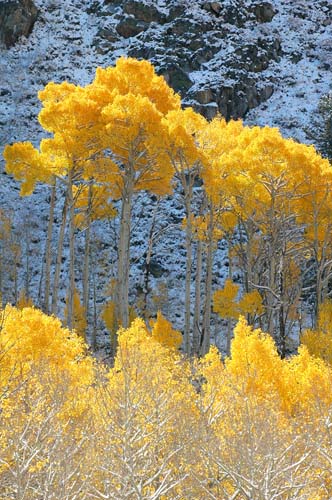 CONCLUSION ON HEAT LOSS:
CONCLUSION ON HEAT LOSS:Preventing heat loss is the best way to avoid hypothermia. If you let things get out of control, it will be far more difficult to reverse the potential damage done to the body due to heat loss, then to prevent it in the first place.
Preventing heat loss.
- Proper clothing is crucial. If you have a good layering system, along with a good water proof, windproof, and breathable shell (like Gortex@) you will greatly reduce or eliminate the danger of heat loss from convection, Evaporation, and (to a much lesser extent), Radiation. This means playing it smart, and being alert to what your body is telling you. You may deceive yourself, but your body doesn't lie. Take heed, and reduce layering when you start to sweat, and add layering when you start to get cold.
- Stay dry. Heat loss from Conduction can be deadly. This is because you loose heat 20-25 time faster when wet. Immediately remove wet clothing. Getting soaked with sweat when it is cold, is usually a sign that you are not playing it smart when it comes to heat regulation. It's one thing to have the layer next to your skin get wet (this is almost unavoidable if you are working hard climbing or hiking. This layer should not be cotton (known as death cloth), but something like smart-wool@ that provides warmth even when wet is a far better choice) but if you ignore your condition, and let your insulating layer get soaked, then you are just plain being foolish and could end up paying a very dear price for your lack of diligence in this area. Once cotton or down gets wet, they will wick heat away from your body at an alarming rate, and even after removing them from your body, it will take some serious dry heat to make them useful again. This is why synthetic clothing and wool are much better choices when it comes to cold damp environments. They still retain some insulating value when wet.
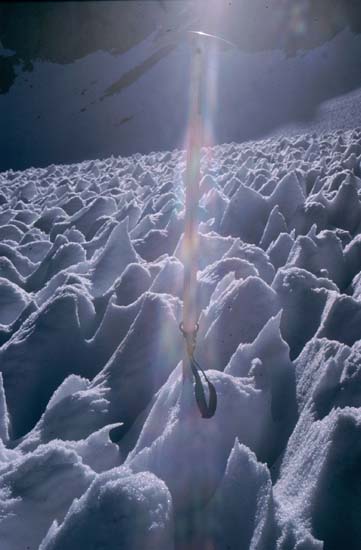 SYMPTOMS OF HYPOTHERMIA
SYMPTOMS OF HYPOTHERMIAIf the above steps are not taken when it comes to heat loss and the human condition, then symptoms begin to appear letting you know that your body is not happy. Things are beginning to go downhill and one or more steps are needed immediately, so that you can stop the downward spiral and get things back on track.
Mild Hypothermia:
- Involuntary shivering.
- Peripheral body parts such as hands, feet, nose, ears, etc. Are becoming numb due to body shutting down blood flow to conserve heat for the body's core.
- Dazed state of mind.
- Strange behavior, demonstrated by poor choices when it comes to survival.
- Slurred speech.
- Loss of fine motor coordination - particularly in hands - You cannot zip up your jacket because of vasoconstriction as mentioned above.
- Aggressive and uncontrollable shivering.
Severe hypothermia
- Chalky/pale skin color.
- Dilated pupils.
- Aggressive shivering, followed by pauses, then back to shivering.
- Flexibility and movement reduced because of a lack of blood flow.
- Person curls up in a tight position in order to conserve heat.
- Slow, intermittent, and/or weak pulse.
Fatal hypothermia
- Breathing becomes very shallow and very erratic.
- Victim is Semi conscious or appears dead.
- Cardiac arrhythmias set in, this leads to ventricular fibrillation resulting in heart failure as the cause of death.
HOW TO ASSESS A HYPOTHERMIC CONDITION:
- Ask the person to stop shivering. If they can then hypothermia is most likely mild.
- If the individual is all curled up into a ball, try to open their arms. If the arms curl back into the original position then the person is most likely still alive.
- Check for a pulse. If you cannot find one and you know that the person is still alive, then it is a sign that the core temperature is most likely less than 88 degrees F. This would put the individual in the severe hypothermic stage.
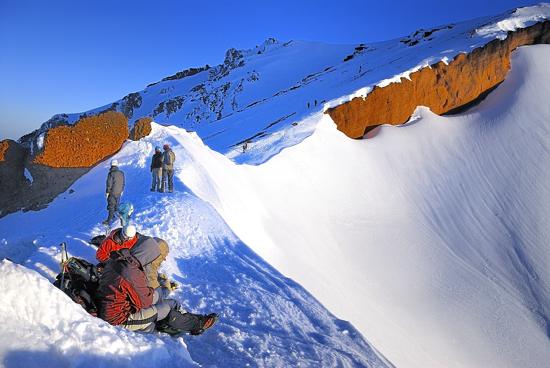 HOW THE BODY RESPONDS TO HYPOTHERMIA
HOW THE BODY RESPONDS TO HYPOTHERMIAWe have gone over much of the way the body handles cold, but to recap all this, the body will do the following in order to do what it can to protect itself from heat loss. As mentioned above, the body is a chemical factory, and the reactions that are required for life are very heat sensitive.
The body will also go into a mode where it will sacrifice appendages such as hands and feet, etc. In order to preserve precious heat for its core organs like the heart, brain, and lungs. This is why it will shut down blood flow to the extremities. This being the case, you do not want to give alcohol (or drink it yourself) to someone when facing cold conditions. Alcohol is a vasodilator and should be strictly avoided when survival is at stake.
Dilated blood vessels are subject to far greater heat loss and can cool the body down at an alarming rate. Many an alcoholic has died from exposure to cold due to this principal. Caffeine is another substance to be avoided. It is a diuretic (pulls water out of the body). This will increase your risk of dehydration and a slowed down circulatory system (due to lower blood volume). This in turn will aggravate a hypothermic condition.
On the other extreme is Tobacco/nicotine. It is also on the avoid list. Nicotine is a vasoconstrictor (narrows the blood vessels) and this condition increases the risk of frostbite. Now this may sound contradictory with the above statement about alcohol (which does the opposite), but things like alcohol and nicotine are indiscriminate in their effect on the body. Meaning that alcohol will dilate vessels everywhere in the body, and nicotine will constrict vessels everywhere. Far better to let your body decide which vessels to constrict and which ones to dilate. Your body will always perform in a way that is best for your survival if not hampered by the above substances.
"For you are fearfully and wonderfully made" Psalm 139:14).
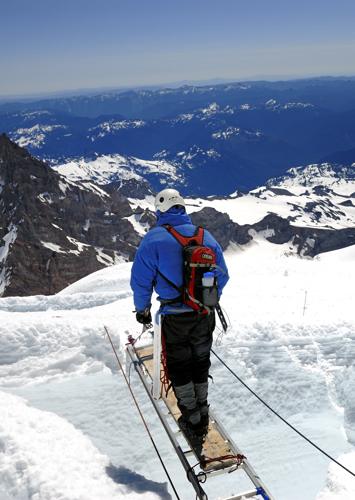 Shivering is also a mechanism that the body uses to produce heat. Shivering is the body's way of putting the muscles to work so that fuel is burned and heat is generated. Far better though to take preventative steps as outlined above, to reduce or stop heat loss, before the body has to take such drastic measures. Shivering is a warning that the body is going into survival mode, and you need to take measures to increase heat through activity, or put on some extra clothing to pull the body out of this type of activity.
Shivering is also a mechanism that the body uses to produce heat. Shivering is the body's way of putting the muscles to work so that fuel is burned and heat is generated. Far better though to take preventative steps as outlined above, to reduce or stop heat loss, before the body has to take such drastic measures. Shivering is a warning that the body is going into survival mode, and you need to take measures to increase heat through activity, or put on some extra clothing to pull the body out of this type of activity.Therefore, in conclusion, the two primary things the body does to combat cold (on its own) is cutting the blood supply to the extremities (to conserve heat for the core), and shivering in order to produce heat. (there are many other things the body does in reaction to cold, but these are the most obvious and recognizable)
OTHER HYPOTHERMIC FACTORS
- Body fat composition - Heavier set people have greater body fat composition and therefore are better insulated.
- Fitness level - People who are more fit, generally have a better metabolism, and burn fuel at a greater rate. This produces heat. They are also better off when it comes to survival, since they will be able to shiver for more extended periods of time. If you can stop further heat loss to the body, a person can increase their internal temperature at a rate of 3.6 degrees F./hour by shivering. This is a substantial increase in body core temperature. But it requires a frightful amount of shivering. Thus, the more fit an individual, the greater their chances will be to reverse their hypothermic condition using this method of operation.
- Exhaustion level - Worn out climbers, hikers, backpackers, etc. are much more susceptible to cold. This is because they have used up all their ready reserves of fuel and energy. Muscles are less able to generate heat (due to the lactic acid build up), and this tends to shut them down. For much more on this subject, see our article on Conditioning, and Outdoor Food.
- Tight Clothing - Make sure that you do not over tighten things like your boots or draw strings on your clothing. Not only is this uncomfortable, but it cuts off circulation This in turn puts that area of the body in greater danger of cold injury. This factor, I believe, played a role in my getting frostbite. In our forced bivouac situation, I failed to loosen up my boots when laying in the snow. This in turn greatly reduced the circulation to my feet, and I ended up with frostbite on my toes.
- Bad Decisions - This factor plays out in many ways. First of all, you can put yourself into a hypothermic condition by failing to turn back on a summit bid. Failure to do so may land you into a forced unprepared bivouac (like what happened to me). Therefore, the best time to correct your thinking and get back on track is before you find yourself shivering uncontrollably because you failed to take necessary precautions. Later on decision making may not be so easy. During World War II, pilots that flew missions during the winter were subject to very cold temperatures during their flights. When they returned to base later on, ground crews found that the pilots were in varying states of hypothermia. Along with this, they also discovered that the pilots thinking was compromised. It took a fair amount of time for them to regain their mental acuity. This plays into your ability to correct your hypothermic situation big time. So the bottom line is this. You need to make good decisions before you slip into a hypothermic state in the first place. Your life just may depend on it.
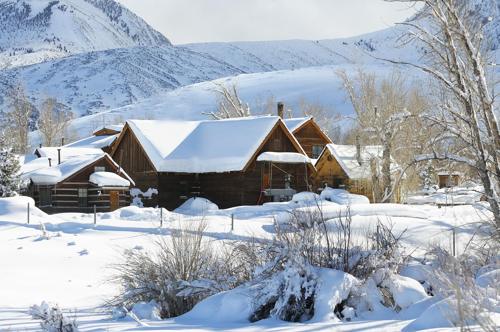 TREATING HYPOTHERMIA
TREATING HYPOTHERMIAObviously the best way to treat hypothermia is to prevent it. But what do you do if you, or one of your companions, has fallen into this condition? Over the many years that I have been climbing, hiking, and backpacking in the mountains, I have had several cases of mild hypothermia, with one more serious case, where I got frostbite on Split Mountain in the California Sierra Nevada. I have to tell you, that I made a whole range of mistakes that led up to that injury. Hopefully I have learned a few things when it comes to preventing and/or treating this situation in the future.
THINGS YOU CAN DO TO HELP YOURSELF IN THE COLD
- Stop further heat loss - Remove all wet clothing and exchange for dry if possible, and add additional layers if needed. This stops radiation and conduction heat loss. If things are really bad, set up your tent or bivy bag, and get into your sleeping bag.
- Get out of the wind - by either taking shelter in the tent, or if you have to be on the move, put on your protective outer shell that should include both wind and rain protection (the shell should also be breathable to prevent moisture from building up due to sweat later on if you are moving)
- Make sure to drink plenty of water to stay hydrated - so that your blood volume stays up to par so that it can flow freely and help distribute life preserving warmth to all areas of the body.
- Loosen up overtightened boots and draw strings on your clothes - so that you are not cutting off circulation.
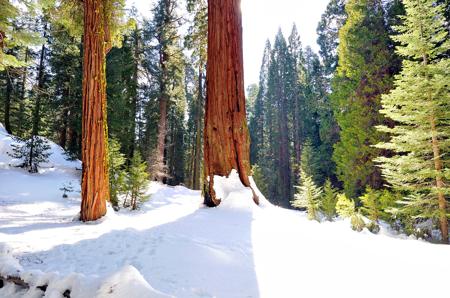
- Eat easily digestible foods and oils - like olive oil to provide fuel for both short term and long term needs. This action is similar to throwing a log on the fire.
- Start a Fire - but this can be difficult, because fires are hard to come by in the wilderness, but if they are allowed, and you have the fuel, then a fire is an incredible way of adding some heat to the equation. However, I find that this is rarely necessary or even practical when mountain climbing. If you have come prepared and have the proper clothing, shelter, and food items, a fire should not be necessary.
- Start up the Stove - and heat up some cool-aid, soup, or other type of liquid. This is a fantastic way to add much needed heat to the body core and take in a bit of fuel at the same time.
- Urinate - A full bladder is another area that the body supplies heat to, and warming up additional liquid in the body taxes the system further. As the body constricts blood vessels in the extremities, more fluid is diverted to the bladder. However, there is a fine balance here, because you also need to replace lost liquid to the vascular system as mentioned above. This is why drinking warm fluids works so well. All this being said, it would not be a bad idea to throw a small container of fuel and a super lightweight stove (and small pot) into your summit bag. It could turn out to be a lifesaver.
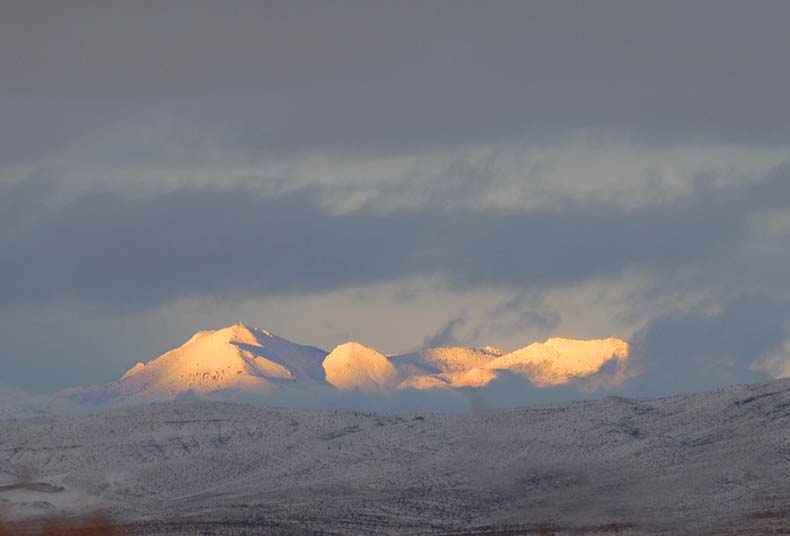
- Apply Heat - if the individual is in really bad shape, you can apply heat to the major arteries in the neck, armpit, crotch and palms, using hot water bottles. Or you could make strips of cloth from an article of clothing, pour warm water on them, and then apply the warmed strips to the body parts as mentioned above. This gets much needed heat to critical areas of the body quickly. In very cold conditions, you will need to reheat the strips over and over again if you are going to have any success in reversing the condition of a severely hypothermic individual. You could also heat up some rocks, wrap them up, and then use them in a similar fashion as indicated above. Rocks tend to maintain heat quite well. Obviously you will need some sort of heat source (like a stove), and care must be taken so that you do not burn the patient.
- Use another person to provide heat - in life threatening situations, it may also be necessary for another individual to get into a sleeping bag with the severely hypothermic individual. This method can provide some long term heat that may not be available by any other means. Also, several individuals huddling together is a much warmer situation than going it alone, because you can greatly limit the exposed areas of each individual by doing this.
- What to do if an individual is semiconscious - If you come across someone who is in a fetal position, or who is semiconscious (due to the cold), be very careful in moving him or her. People in this state could be killed if cold blood is sent to the heart from the extremities. This condition is know as "After-drop" It can best be avoided by not rewarming the extremities but by rewarming the core only. Obviously, do not expose the individual (or anyone for that matter) to extremes of heat.
If you are any of your party members develop frostbite, there are a few things to remember while out in the field. First, as mentioned above, stop further heat loss. Next, do not rewarm the affected area unless you are able to maintain proper warmth for the entire rest of the trip. Frozen, thawed, and then refrozen flesh causes far greater damage than flesh that has only been frozen once. If your feet are involved do not rewarm them if you have to hike out. Much less damage will be done if you walk out on a frozen foot then if the foot is thawed out (not to mention the pain). When I got frostbite my companions carried all my gear so that I I had as little weight as possible on my feet. Once back in civilization you need to get to a doctor or hospital right away. Let them do any further rewarming or treatment.
Blisters often accompany frostbite and should not be broken. Breaking them could risk infection. They usually go away on their own. Leave all additional treatment to your doctor. This is just a bit of advice while out in the wilderness and away from medical help. Being helicoptered out is also an option in very serious cases.
FYI
Frostbite will not occur if the temperature is above 28 degrees Fahrenheit. This is because your intracellular fluid also includes salts. When the fluid inside the cell freezes, the delicate balance of salinity changes and fluid is drawn into the cell. This eventually causes the cell to burst causing both tissue damage and blisters to form in the affected area.
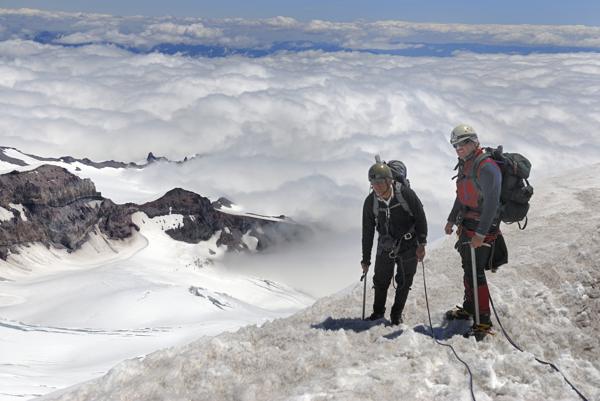 CONCLUSION:
CONCLUSION:Hypothermia, like just about every other ailment that I can think of, is easier to prevent than to treat. But if one is to avoid this condition you need to use your head when going out on frigid outdoor adventures. You also need to be prepared. This means carrying, and wearing proper clothing, including proper shelter.
Carrying adequate food, and drinking proper amounts of water is also very important. Doing all this will prevent just about every case of hypothermia. I have tried to give you several guidelines above, and I hope that they have been helpful. I would also like to mention that the information in this article is limited, and it is not intended to be a complete or an end all on the subject of hypothermia by any means.
So make sure to continue your education on this subject and the many others involved in outdoor activities. Get all the training you can from qualified people in all area of wilderness travel. By doing this, you will be better trained to avoid senseless injuries or even loss of life on your future journeys.
Email Sign Up
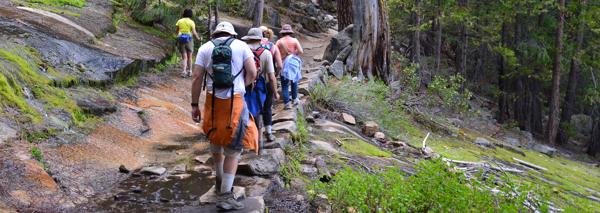
| Join the Adventure! Sign up here for Timberline Trails Monthly Newsletter |

Join us on Instagram

©2006-2022 TimberlineTrails. All Rights Reserved.